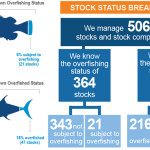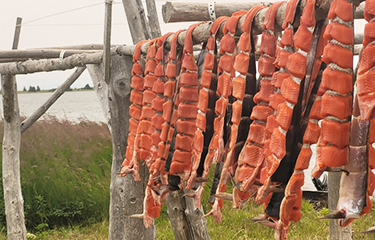Abysmal chinook and chum salmon returns to Western Alaska have made the state’s jurisdiction in fisheries management a prominent target for lawsuits this year.
Though Alaska’s subsistence challenges have been the bane of salmon management in some areas for more than a half century, recent run failures on the Yukon and Kuskokwim rivers have rekindled arguments in the courts. One ongoing case will determine whether the State of Alaska and the Alaska Division of Fish and Game or the federal government calls the shots in setting subsistence openings and closures on a 191-mile stretch of the river.
“They’re literally fighting over crumbs here,” U.S. Rep. Mary Peltola (D-Alaska) said. “This is a legal battle over crumbs. All subsistence harvesting captures less than 1 percent of Alaska’s resources. When I was growing up it was 2 percent, which was negligible; now it’s less than 1 percent, and when you’re talking about subsistence on federal land, that’s infinitesimal.”
The case is the latest in court gyrations that promise to test the validity of a landmark court ruling that was never settled to anyone’s satisfaction in the 1990s. That case, commonly referred to as “Katie John,” named after the woman who challenged a 1964 state law that prevented her from operating a fish wheel, was supposed to have defined “subsistence priority” in fisheries management.
The suit, originally filed in 1985 by Katie John and other parties, challenged the state management system in a plea for subsistence rights. What ensued since then has been a fight between state and federal courts in defining what constitutes public lands, submerged lands, navigable waters on those lands, and which government – state or federal – has rightful management of those waters to comply with language in the Alaska National Interest Lands Conservation Act (ANILCA).
As the Katie John case was being decided, an Alaska Supreme Court decision in another case, McDowell v. State, ruled natural resources are the property of all residents: urban, rural, Native, and non-Native, and that relegating rights to specific groups violated the state constitution. The McDowell ruling clarified the state’s position on the allocation of resources, and the 9th Circuit U.S. Court of Appeals then ruled in favor of Katie John.
On the surface, the two decisions appeared to have been a definitive win for groups in rural Alaska. But ongoing legal challenges by the state of Alaska, and a separate case of a hunter, John Sturgeon, who tested federal law by running a hovercraft into the headwaters of a national park, complicated matters. The ensuing Sturgeon v. National Park Service case originated in 2011, testing Sturgeon’s assertion that he was operating legally under state jurisdiction on public lands. The National Park Service argued otherwise, but the U.S. Supreme Court sided with Sturgeon in November 2018, superseding the 9th Circuit ruling that upheld Katie John.
In its current legal battle, Alaska has everything to lose in its management of resources and in protecting the sovereignty to serve its residents. Advocates for rural communities say losing access to salmon that have been harvested by other user groups compromises tradition, health, and wellness, and even village economics.
“Right now, this discussion is not about Native and non-Native,” said Peltola, who has lived and fishes on the Kuskokwim River. “It is about rural and non-rural harvests, and what it’s saying is that if you live in close proximity to the resource in lower abundance, then the person who lives in that proximity has a priority of harvest.”
In many communities across Alaska, which have struggled with historically low salmon runs in recent years, local subsistence needs have not been met.
“The cash economy along the road system and in urban Alaska is very different from the economy in rural and remote Alaska,” Peltola said. “Our economy is actual food on the table.”
In October 2023, the Alaska Federation of Natives (AFN) put forth a list of resolutions challenging the state of Alaska on its failure to manage the Kuskokwim salmon effectively. The U.S. District Court judge hearing the case allowed AFN to join the case as an intervenor. Alaska’s Department of Law said it does not intend to undermine the precedent that upholds Katie John in its defense.
“The title of the case shows that the state of Alaska did not bring this lawsuit,” the Alaska Department of Law said in a 21 October press release. “The federal government did. The state had no interest in revisiting the Katie John case.”
In its filing, AFN said it seeks subsistence rights protection for 160,000 residents directly affected by future court decisions and their implications to the state’s subsistence fishery management regime. For her part, Peltola said she backs the definition of “rural priority” as being confined to immediate residents of the communities.
“If I live in the Kuskokwim River, I do not have rural preference to harvest on the Yukon River,” she said. “So, if any area in Alaska has scarcity issues, the people who live close to that resource have the first shot. I think that’s a really fair threshold.”
Attorneys for the state, however, said management of salmon and other natural resources applies to all people, including Alaska Natives who have left those villages to live in Alaska’s largest cities.
“Today, 60 percent of Alaska Native people reside in the state’s urban cities, not its rural villages, and 87 percent live outside of tribal areas,” the Alaska Department of Law said. “State laws and regulations protecting subsistence fishing for all Alaskans ensure that Alaska Native people can return home to practice their culture and traditions through subsistence fishing.”
Earlier this month, the state of Alaska requested a summary judgment, according to Patty Sullivan, communications director with the Alaska Department of Law.
All sides concur that the final rule about who manages the fishery and who has ultimate access to the fish will likely follow the path of the Sturgeon case up to the U.S. Supreme Court.
The litigation promises to pit Native against non-Native residents, rural residents against urban residents, state managers against federal managers, and like other large-scale changes in fisheries management changes, opens the possibility of unintended outcomes.
“Anybody who’s ever fished for chum salmon with a gillnet knows that there are spinners. It’s hard getting one out of the net, and sometimes during the peak of the run you get four or five or six that are all tangled together,” Peltola said. “I used to see these chums in my sleep, and I feel that we are there now. It’s like two or three chums that are twisted up in a knot together.”
Reporting by Charlie Ess
Photo courtesy of Scott Bartlett







